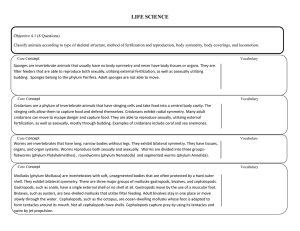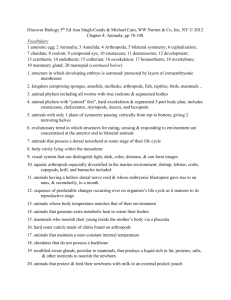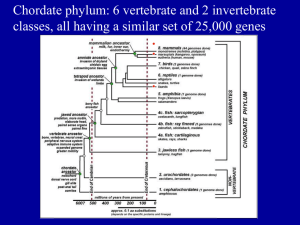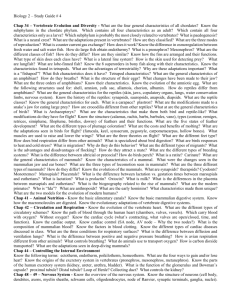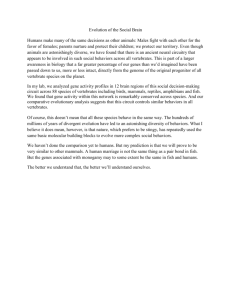life science
advertisement
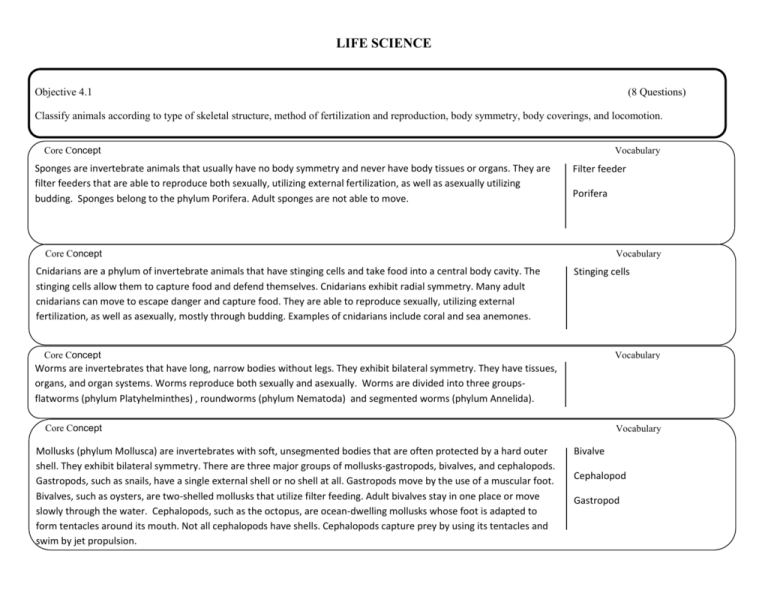
LIFE SCIENCE Objective 4.1 (8 Questions) Classify animals according to type of skeletal structure, method of fertilization and reproduction, body symmetry, body coverings, and locomotion. . Core Concept Sponges are invertebrate animals that usually have no body symmetry and never have body tissues or organs. They are filter feeders that are able to reproduce both sexually, utilizing external fertilization, as well as asexually utilizing budding. Sponges belong to the phylum Porifera. Adult sponges are not able to move. Vocabulary Filter feeder Porifera Core Concept Cnidarians are a phylum of invertebrate animals that have stinging cells and take food into a central body cavity. The stinging cells allow them to capture food and defend themselves. Cnidarians exhibit radial symmetry. Many adult cnidarians can move to escape danger and capture food. They are able to reproduce sexually, utilizing external fertilization, as well as asexually, mostly through budding. Examples of cnidarians include coral and sea anemones. Vocabulary Stinging cells Core Concept Vocabulary Worms are invertebrates that have long, narrow bodies without legs. They exhibit bilateral symmetry. They have tissues, organs, and organ systems. Worms reproduce both sexually and asexually. Worms are divided into three groupsflatworms (phylum Platyhelminthes) , roundworms (phylum Nematoda) and segmented worms (phylum Annelida). Core Concept Mollusks (phylum Mollusca) are invertebrates with soft, unsegmented bodies that are often protected by a hard outer shell. They exhibit bilateral symmetry. There are three major groups of mollusks-gastropods, bivalves, and cephalopods. Gastropods, such as snails, have a single external shell or no shell at all. Gastropods move by the use of a muscular foot. Bivalves, such as oysters, are two-shelled mollusks that utilize filter feeding. Adult bivalves stay in one place or move slowly through the water. Cephalopods, such as the octopus, are ocean-dwelling mollusks whose foot is adapted to form tentacles around its mouth. Not all cephalopods have shells. Cephalopods capture prey by using its tentacles and swim by jet propulsion. Vocabulary Bivalve Cephalopod Gastropod LIFE SCIENCE Core Concept Vocabulary Birds (phylum Chordata) are a class of endothermic vertebrate animals whose bodies are covered with feathers and have a four-chambered heart. They have the ability to fly using their wings. Birds have internal fertilization and lay eggs. They exhibit bilateral symmetry. Most parent birds will care for their young until they are able to fly. Core Concept Vocabulary Mammals (phylum Chordata) are class of endothermic vertebrate animals that have a four-chambered heart and skin covered with fur or hair. Most mammals are born alive and are fed with milk produced by the mother. Most mammals walk or run on four limbs. They have bilateral symmetry. Mammals are classified into three groups based on how their young develop-monotremes, marsupials, and placental mammals. Mammals usually care for their young for an extended period of time. All mammals reproduce with internal fertilization. Core Concept Arthropods (phylum Arthropoda) are invertebrates that have an external skeleton, a segmented body, and jointed appendages. The major groups of arthropods are crustaceans, arachnids, centipedes and millipedes, and insects. They have bilateral symmetry and most reproduce sexually. Arthropods have mouthparts that are specialized for chewing their food. Most arthropods have the ability to move through the use of legs. Insects have wings that allow for flight. Crustaceans include crabs and shrimp. Arachnids include spiders and ticks. Insects include mosquitoes, bees, and grasshoppers Vocabulary Arthropod Core Concept Fish: Fish are vertebrates that live in water and breathe with gills. Fish are ectotherms, or cold-blooded. Fish have either backbones of cartilage or bone. Most fish are adapted to live in salt or fresh water. Most fish have fins and scales, which cover and protect the body. The body systems of the fish, such as the digestive, circulatory, etc. are well developed. The fish are further classified into three classes. These classes are the jawless fish such as the hagfish and lampreys; the fish whose skeleton is made of cartilage such as sharks, rays and skates; and the fish whose skeleton is composed mostly of bone such as bass, perch, catfish, and flounder. Vocabulary Core Concept Reptiles: Reptiles are vertebrates which can breathe air and are cold blooded (cannot regulate body temperature). Their bodies are covered with scales or scutes (similar to scales but typically found on feet of birds and crocodiles and shells of turtles) and they lay amniotic eggs (embryos develop inside amniotic membranes) on land. Reptile’s characteristics include internal fertilization, as sperm gets deposited into the reproductive tract of the female directly. The offspring of reptiles resemble the adults at the time of birth itself. There is no metamorphosis, as in the case of amphibians. Physical characteristics of reptiles include their keen sense organs, which help them to find food and escape from predators. Eyes are one of the most important sense organ and in most reptiles; these organs are located at the front of the head to facilitate binocular vision Vocabulary Scutes
